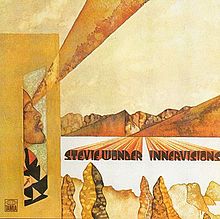In review: Stevie's Wonderland
Motown/Universal (1973)
Ah, Stevie, how did I
forget you for so many years? I grew up with Stevie Wonder music surrounding
me. Then when I was in college, I took a
dance class and our final performance featured Sir Duke. However, after I
discovered alternative rock, I stopped listening to soul music, and poor Mr.
Wonder was relegated to the back closets of my mind. That was until a few months ago when I heard Sir Duke playing the background at the
food coop. Stevie was back and just in
time, since now I decided to include a chapter on soul music for my
book-in-progress, Whole Music. Oh, I’m
enjoying this.
When Stevie released Innervisions in 1973 I was in grade
school, but I heard the gritty socio-commentary Living for the City, the catchy Don’t
You Worry “Bout a Thing, and the funky Higher
Ground on a pop radio station.
However, at the time I did not recognize Wonder’s musical genius. I knew nothing about song crafting, ethnic
rhythms, or music production. Now, that
I have listened to everything from Mozart, to Aretha Franklin, to field recordings
of drumming virtuosos, I feel astounded by the beauty and power of Innervisions.
First, Wonder plays most
of the instruments himself, including those salsa piano riffs on Don’t You Worry, his voice swoops and
soars like a combination of a West African griot and a gospel singer of the
black church. His songwriting must have turned
other musicians’ faces green with envy and these songs run the wide gamut
between all-out gospel (Jesus Children of
America and listen to that churchy piano at the beginning of Golden Lady), funk (Living for the City), ballads (Visions,
Golden Lady, All In Love is Fair), and salsa (Don’t You Worry ‘Bout a Thing).
The musician wonder also provides some cheeky humor such as his little
Spanish skit at the beginning of Don’t
You Worry and in the text of He’s
Misstra Know-It-All, which in itself has a Beatles-esque quality. I can hear Paul McCartney crooning this song.
It is not often that I sit
mesmerized with my finger on the replay button, but I could spend an entire day
listening to this single album. Besides,
all the glowing accolades I mentioned above, I feel the changing moods of these
songs strongly. I resonate with the keys
on Visions, Golden Lady, and All In Love Is Fair in which Wonder’s vocals grab my heart and
nearly yank it out of my chest. I would
need to listen to all Wonder’s albums to know which one has the best vocals,
but I imagine this album is at the top of the list. Wonder goes full-throttle on this flawless
album. He also experimented with the
Moog and ARP synthesizers of that era. And
I will say, from a college class learning the ARP synthesizer, that you had to
program each sound with patch cords (you did not just push buttons). Here is just another memory, compliments of
Stevie Wonder.




Comments
Post a Comment